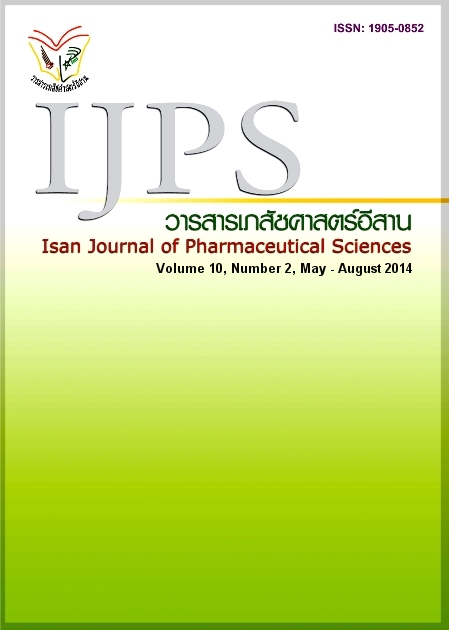Satisfaction of Khon Kaen University Personnels toward Drug Information Received from Pharmacies
Main Article Content
Abstract
Introduction: Lack of adequate drug information from pharmacies not only decreases patient satisfaction but may also has a negative effect on drug use, drug safety and patient compliance. This study was a research survey to determine the quality of drug information received from pharmacies and to determine the degree of customer satisfaction regarding drug information. We compared quality of information received and and patient satisfaction between 2 patient groups: those who specified the name of medicines they sought and those who sought medicines by describing their symptoms. Methods: The research sample consisted of 515 Khon Kaen University personnel who visited the pharmacy within 6 months before the collecting time. Questionnaires validated by community pharmacy professionals were used for data collection. The data was analyzed and reported by frequency and percent. Chi-square test and Fisher’s exact test were used to compare the results between groups. Results: Most of the Khon Kaen University personnel, who visited the study pharmacies, received sufficient information with regard to “Name of the medicines”, “The indication of the medicines”, “Understandable instruction for using the medicine”, and “Course of treatment” (79.4%, 83.7%, 84.7% and 77.5%, respectively). But in the case of the depth of information needed, there was a trend that patients received insufficient information or sometimes none at all. Patients who described their symptoms gave significantly higher ratings for drug information received and higher ratings for satisfaction than patients who specified the name of medicines (p<0.05 for each category). Conclusions: Most Khon Kaen University personnel who participated in this study were moderately satisfied with the drug information they received. To increase their drug information satisfaction, the community pharmacists should improve their information service by probing patient needs and respond sufficiently to further improve patient satisfaction, and impact on drug use, drug safety and patient compliance.
Article Details
In the case that some parts are used by others The author must Confirm that obtaining permission to use some of the original authors. And must attach evidence That the permission has been included
References
Barber N, Parsons J, Clifford S, Darracott R, Horne R. Patients’ problems with new medication for chronic conditions. Qual Saf Health Care 2004 Jun; 13(3): 172-175.
Bearden, William O, Teel Jesse E. Selected Determinants of consumer satisfaction and complaint reports. JMR 1983 Feb; 20(1): 21-28.
Caruana Albert. Service loyalty: The effects of service quality and the mediating role of customer satisfaction. EUR J MARKETING 2002; 36(7/8): 811-828.
Horne R, Hankins M, Jenkins R. The Satisfaction with information about medicines scale (SIMS): a new measurement tool for audit and research. Qual Health Care 2001 Sep; 10(3): 135-140.
Hoyer Wayne D, MacInnis Deborah J. Part XI: Post-decision processes. Consumer Behavior. 5th ed. South-Western CENGAGE Learning 2010; 271-295.
Keawkes A, Phayom S, Theerapong S. Satisfaction and Opinion of Mahasarakham University Population toward the University Pharmacies. J Sci Technol MSU 2010; 29(4): 428-438.
Nilwas K, Napalai N, Sutatsawan J. Customer satisfaction towards services of accredited and general drugstores. JHS 2006; 15(1):133-140.
Parasuraman A, Zeithaml Valarie A, Berry Leonard L. A conceptual model of service quality and its implications for future research. JM 1985; 49(4): 41-50.
Singh H. The importance of customer satisfaction in relation to customer loyalty and retention. Asia Pacifi c University college of technology and innovation working paper; 2006.
T.Sriwong B. Consumers’ preferences toward Prince of Songkla University Demonstration. Songkla Med J 2004 Aug; 22(2): 393-399.

